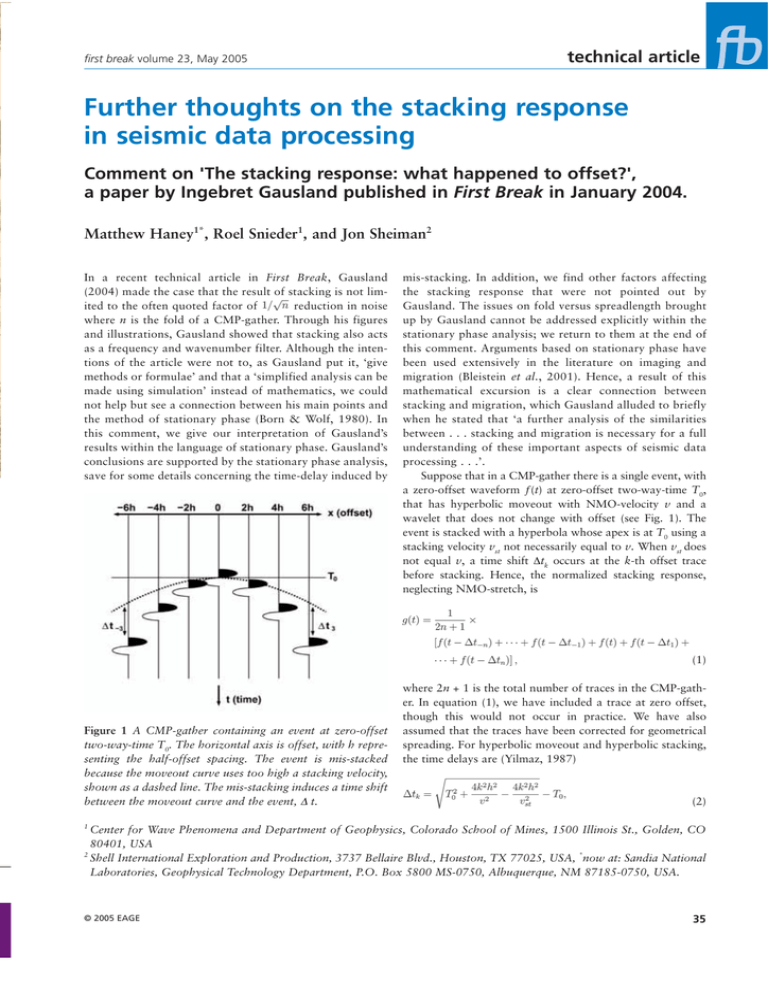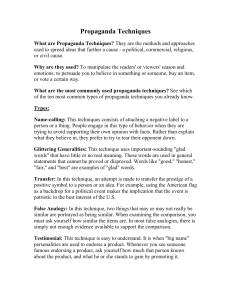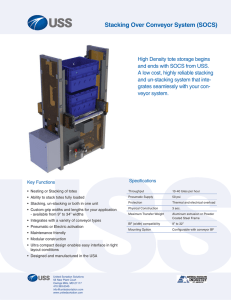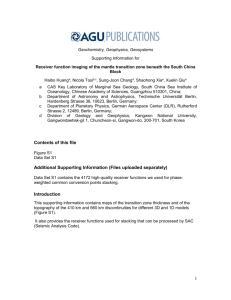Further thoughts on the stacking response in seismic data processing technical article
advertisement

technical article first break volume 23, May 2005 Further thoughts on the stacking response in seismic data processing Comment on 'The stacking response: what happened to offset?', a paper by Ingebret Gausland published in First Break in January 2004. Matthew Haney1*, Roel Snieder1, and Jon Sheiman2 In a recent technical article in First Break, Gausland (2004) made the case that the result of stacking is not limited to the often quoted factor of reduction in noise where n is the fold of a CMP-gather. Through his figures and illustrations, Gausland showed that stacking also acts as a frequency and wavenumber filter. Although the intentions of the article were not to, as Gausland put it, ‘give methods or formulae’ and that a ‘simplified analysis can be made using simulation’ instead of mathematics, we could not help but see a connection between his main points and the method of stationary phase (Born & Wolf, 1980). In this comment, we give our interpretation of Gausland’s results within the language of stationary phase. Gausland’s conclusions are supported by the stationary phase analysis, save for some details concerning the time-delay induced by mis-stacking. In addition, we find other factors affecting the stacking response that were not pointed out by Gausland. The issues on fold versus spreadlength brought up by Gausland cannot be addressed explicitly within the stationary phase analysis; we return to them at the end of this comment. Arguments based on stationary phase have been used extensively in the literature on imaging and migration (Bleistein et al., 2001). Hence, a result of this mathematical excursion is a clear connection between stacking and migration, which Gausland alluded to briefly when he stated that ‘a further analysis of the similarities between . . . stacking and migration is necessary for a full understanding of these important aspects of seismic data processing . . .’. Suppose that in a CMP-gather there is a single event, with a zero-offset waveform ƒ(t) at zero-offset two-way-time T0, that has hyperbolic moveout with NMO-velocity v and a wavelet that does not change with offset (see Fig. 1). The event is stacked with a hyperbola whose apex is at T0 using a stacking velocity vst not necessarily equal to v. When vst does not equal v, a time shift ∆tk occurs at the k-th offset trace before stacking. Hence, the normalized stacking response, neglecting NMO-stretch, is (1) Figure 1 A CMP-gather containing an event at zero-offset two-way-time T0. The horizontal axis is offset, with h representing the half-offset spacing. The event is mis-stacked because the moveout curve uses too high a stacking velocity, shown as a dashed line. The mis-stacking induces a time shift between the moveout curve and the event, ∆ t. where 2n + 1 is the total number of traces in the CMP-gather. In equation (1), we have included a trace at zero offset, though this would not occur in practice. We have also assumed that the traces have been corrected for geometrical spreading. For hyperbolic moveout and hyperbolic stacking, the time delays are (Yilmaz, 1987) (2) 1 Center for Wave Phenomena and Department of Geophysics, Colorado School of Mines, 1500 Illinois St., Golden, CO 80401, USA 2 Shell International Exploration and Production, 3737 Bellaire Blvd., Houston, TX 77025, USA, *now at: Sandia National Laboratories, Geophysical Technology Department, P.O. Box 5800 MS-0750, Albuquerque, NM 87185-0750, USA. © 2005 EAGE 35 technical article first break volume 23, May 2005 where h is the half-offset spacing (assumed to be regular) and the subscript k represents the k-th trace from zero-offset (see Fig. 1). Note that the time delays vanish when vst = v (perfect stacking). Denoting the Fourier transforms of ƒ(t) and g(t) as F(ω) and G(ω), the transform of equation (1) may be written (3) (8) This type of integral can be approximately evaluated by the method of stationary phase (Born & Wolf, 1980; Bleistein et al., 2001). Within this approximation, I(ω) is given by (9) where the transfer function, K, is (4) At this point, since we are in the frequency domain, NMOstretch could be included as amplitude and dilation factors in the exponentials appearing in the series (Yilmaz, 1987); however, in the interest of simplicity, we do not account for it here. For the particular case of linear moveout (T0 = 0), the series in equation (4) is a geometric series and can be evaluated exactly (Lu, 1993). The ‘familiar array equation’ pointed out by Gausland comes from this approach. The series is geometric because the respective time delays are regularly spaced (∆tk = k∆t1). When the moveout is nonlinear, for instance hyperbolic, the time delays are not regularly spaced and the series in equation (4) cannot be evaluated exactly. To obtain his results, Gausland chose some values for T0, n, ω, h, and v and numerically calculated K(ω) with equation (4). We proceed by approximating equation (4) with an integral and evaluating it by the method of stationary phase (Born & Wolf, 1980; Bleistein et al., 2001). First, note that the fold of the CMP-gather, 2n + 1, is related to the spreadlength, Ls, and the half-offset spacing, h (5) Using the definition from equation (5), the finite series of equation (4) may be rewritten as (6) The finite series in equation (6) looks like a discretized integral (Riemann sum) over offset. Taking the limit of continuous sources and receivers, n ∞ and h 0, and allowing the discrete variable 2kh to become the continuous variable x results in (7) We simplify the evaluation of the integral in equation (7) by letting the spreadlength go to infinity, Ls ∞. This simplification avoids accounting for Cornu’s spiral (Born & Wolf, 1980). Denoting I(ω) = K(ω) Ls as a scaled version of the transfer function gives 36 with xst the stationary point of the phase function φ (x) of equation (8) where (10) In equation (9), the subscript x = xst indicates the quantity is to be evaluated at the stationary point. To find the stationary point, we set the x-derivative of φ (x) to zero and identify the stationary point xst = 0, where the moveout curve and the stacking curve are tangent (see Fig. 1). After calculating the second x-derivative of the phase function and evaluating it at the stationary point, the scaled transfer function I(ω) can be expressed, in the stationary phase approximation, as (11) where (12) Note that the stationary phase approximation is an asymptotic series - it is valid in the limit of ω ∞. The limiting quantity can be expressed in terms of a dimensionless number instead of ω (Bleistein et al., 2001; p. 131). In this way, the accuracy of the stationary phase approximation depends on ω being large relative to another quantity. Equation (11) states that, when an event is stacked with a velocity that is not the true velocity, a phase shift of ±45 results depending on whether the stacking velocity is higher or lower than the true velocity. The amplitude of I(ω) scales with and as a function of stacking velocity. It is worth noting that the amplitude of the scaled transfer function I(ω) ‘blows up’ when vst = v. This is due to the fact that the stationary phase approximation is not valid for vst = v; in that case, the entire moveout curve is tangent to the stacking curve. The stationary phase approximation is therefore meaningful only when vst ≠ v. From equation (11), the amplitude response is inversely proportional to . Hence, stacking errors cause the stacked waveform to be enriched in lower frequencies - an effect identical to stacking NMOstretched waveforms. This low-pass filtering of the waveforms due to stacking errors has been mentioned previously © 2005 EAGE technical article first break volume 23, May 2005 by Bleistein et al. (2001). On page 15, the authors state that ‘the high frequencies of the data may be suppressed by stacking. This is because the arrivals may not be exactly aligned before stacking, causing the stacking process to sum higher frequency components out of phase’. Through figures showing the amplitude and time delay of the stacking response as a function of stacking velocity, Gausland (2004) limited his discussion of the stacking response to the amplitude decay term, , and the phase shift, sgn(vst - v)π/4. In Figs. 2 and 3, we plot the amplitude and phase as a function of stacking velocity for the acquisition parameters used by Gausland (T0 = 2 s, ω = 25 Hz, v = 2500 m/s, n = 48, and Ls = 4800 m) and for the scaled transfer function in the stationary phase approximation, equation (11). The trend of the exact solution agrees with the stationary phase approximation. Note that, in his article, Gausland (2004) plotted the phase shift θ, shown in Fig. 3, as a time-delay by using tdelay = θ/ω. With this relationship between time-delay and phase shift, Gausland claimed that the timedelay ‘. . . is frequency dependent, and will be inversely proportional to frequency . . .’. However, as seen in equation (11), the effect of mis-stacking is not purely amplitude decay and phase-shift as a function of stacking velocity. There is the factor of 1/ , which, when coupled with the ±450 phase-shifts, acts to halfintegrate a waveform in the process of mis-stacking. This effect can be thought of as both a time-delay and blurring. If an event had an infinite moveout velocity (v ∞) and was stacked in the offset domain with a finite stacking velocity, an analogy would exist between the stacking response, equation (11), and migration by diffraction summation. This analogy exists because an event with an infinite moveout velocity in the offset domain looks like a horizontal reflector in the midpoint domain, as shown in Fig. 4. To pursue this further, as v ∞, equation (11) becomes Figure 2 Amplitude of the stacking response in the stationary phase approximation (thick, black line) and the exact solution (thin, blue line) for the acquisition parameters: T0 = 2 s, ω = 25 Hz, v = 2500 m/s, n = 48, and Ls = 4800 m. (13) Figure 3 Phase of the stacking response in the stationary phase approximation (thick, black line) and the exact solution (thin, blue line) for the acquisition parameters: T0 = 2 s, ω = 25 Hz, v = 2500 m/s, n = 48, and Ls = 4800 m. Two of the three corrections made to simple diffraction summation for Kirchho migration are shown in equation (13). The factor requires multiplying the result of diffraction summation by to recover the true waveform after diffraction summation. Yilmaz (1987) calls this the 2D geometrical spreading factor. Furthermore, recovery of the true waveform after diffraction summation also requires multiplying by exp(iπ/4) , the half-derivative. This correction is called the wavelet shaping factor (Yilmaz, 1987). The final correction to diffraction summation, known as the obliquity factor (Yilmaz, 1987), does not appear in this analogy since the reflector we study here is horizontal. The obliquity factor is relevant only for dipping reflectors. Finally, we come back to the issue why the important parameter for the stack response is the spreadlength and not the fold. Gausland (2004) nicely made this observation in his discussion of the stack as an array; where does the fold ver- sus spreadlength issue appear in our stationary phase analysis? Since we (a) took the sources and receivers to be continuously distributed in equation (7) and (b) let the spreadlength be infinite in equation (8), the result of the stationary phase analysis, equation (11), does not contain either the fold or the spreadlength. Hence, equation (11) says nothing about the fold versus spreadlength issue. Knowing the assumptions that brought the derivation to the point of applying the stationary phase approximation, though, we can see why the spreadlength is the parameter which governs the stack response and not the fold. The fold issue has to do with our allowing the sources and receivers to be continuously distributed. Having a finite number of sources and receivers instead is identical to approximating an integral of a curve with a finite number of rectangles underneath the curve. This is why we invoked continuous receivers in moving from a series to an integral in equation (7). Therefore, © 2005 EAGE 37 technical article Figure 4 Migration of a horizontal reflector by diffraction summation in the midpoint domain. Stacking an event with infinite moveout velocity would look the same as in this plot, except that it would be in the offset domain (compare with Fig. 1). Hence, an analogy exists between migration and stacking in this case. differences in fold translate into differences in sampling of the integrand of equation (7). As long as the sampling is sufficient to avoiding aliasing, the series quickly approaches the integral. This fact is evident in Gausland’s third figure where the seemingly random ‘chatter’ at low stacking velocities, or steep moveouts, disappears when moving from a fold of 12 to a fold of 48. As long as aliasing is not a problem, the issue of fold is purely one of sampling. Regarding spreadlength, we earlier mentioned, prior to equation (8), that taking the spreadlength to be infinite meant not accounting for Cornu’s spiral. Cornu’s spiral is a parametric plot (see Fig. 5) of the Fresnel cosine and sine integrals as their upper limit (the spreadlength) goes to ∞ (Born & Wolf, 1980). These integrals are central in the development of the stationary phase approximation. As the spreadlength gets larger and larger, the two integrals approach the same value, as seen in Fig. 5. At this limiting point, the angle they make with the x-axis is 450; this is an indication of the 450 phase shifts appearing in the stationary phase approximation, equation (11). Away from this limiting point, the two integrals spiral around; this gives rise to the ‘wobble’ seen in the phase shift versus stacking velocity plot in Fig. 3. The spiralling also gives rise to the ‘wobble’ seen in the amplitude versus stacking velocity plot in Fig. 2. As seen in Fig. 2 and Gausland’s fourth figure, the 38 first break volume 23, May 2005 Figure 5 Cornu’s spiral; adapted from Born & Wolf (1980). The x-axis is the Fresnel cosine integral (FresnelC) and the yaxis is the Fresnel sine integral (FresnelS). This is a parametric plot where the Fresnel cosine and sine integrals are plotted as a function of their upper limit, with their lower limit at zero. When the upper limit is zero, the curve is at the origin. As the upper limit ∞, the curve spirals in toward the point (0.5,0.5). Similarly, as the upper limit – ∞, the curve spirals in toward the point (-0.5,-0.5). The fact that the Fresnel cosine and sine integrals have equal values at their limiting point is an indication of the 450 phase shift that comes from the stationary phase approximation, equation (9). length scale of the ‘wobble’ is directly related to the width of the main lobe. Hence, the main factor of importance to the stack response, as long as aliasing is not an issue, is the spreadlength, as witnessed by its role in Cornu’s spiral. In closing, we wish to thank Xiaoxia Xu of CSM for bringing to our attention the book by Lu (1993). References Bleistein, N., Cohen, J. K., and Stockwell, Jr., J. W. [2001] Mathematics of multidimensional seismic imaging, migration, and inversion. Springer-Verlag, NewYork. Born, M. and Wolf, E. [1980] Principles of Optics. Cambridge University Press, Cambridge. Gausland, I. [2004] The stacking response: what happened to offset? First Break 22, 1, 43-46. Lu, J. [1993] The principles of seismic exploration. Press of the Petroleum Chinese. Yilmaz, Ö. [1987] Seismic Data Processing. Society of Exploration Geophysicists, Tulsa. © 2005 EAGE






